The Dangers of Fire Pits on Patio Surfaces
Fire pits are a popular addition to outdoor living spaces that provide warmth and a cozy atmosphere. However, they can also pose a significant risk to your patio surface. Whether it’s a wooden deck, concrete patio, or pavers, fire pits can cause damage if not used correctly. Here are some of the dangers of fire pits on patio surfaces and how to protect your outdoor space.
First and foremost, fire pits produce extreme heat that can cause damage to concrete surfaces. The intense heat can also cause flammable material like wood chips and dried leaves to catch fire, creating a dangerous situation. Wood-burning fire pits are especially risky because they produce embers and sparks that can fly out and ignite nearby structures.
To minimize the risks, it’s essential to invest in a spark screen that fits over your fire pit. This accessory prevents sparks and embers from flying out and landing on your patio surface. In addition to a spark screen, you can also use heat shields and heat retardant mat to protect your patio surface from heat transfer and prevent heat damage.
Another option is to create a layer of sand around the fire pit. Sand is an excellent option because it acts as a natural insulation material that absorbs heat and reduces the risk of fire. If you have a wooden patio surface, it’s essential to use a heat-resistant mat or hinged doors to protect the structural integrity of the wood from pit damage.
Moreover, propane fire pits are a safer alternative to wood-burning fire pits because they produce less smoke and don’t require flammable material like wood chips and dried leaves. Propane gas also burns cleaner than wood, reducing the risk of exposure to heat stress and heat-sensitive surfaces.
In conclusion, fire pits can be a great addition to your outdoor living space, but they require extra precautions to ensure your patio surface remains undamaged. Using a spark screen, thermal barriers, heat-resistant mats, and layer of sand, in addition to investing in a gas fire pit, ensures your patio remains safe and protected from heat damage. Remember also to have a bucket of water and poker tool nearby to put out any flames as necessary. By taking these simple steps, you can protect your patio from damage, allowing you to enjoy your outdoor space without worry.
What is Needed for Protection?
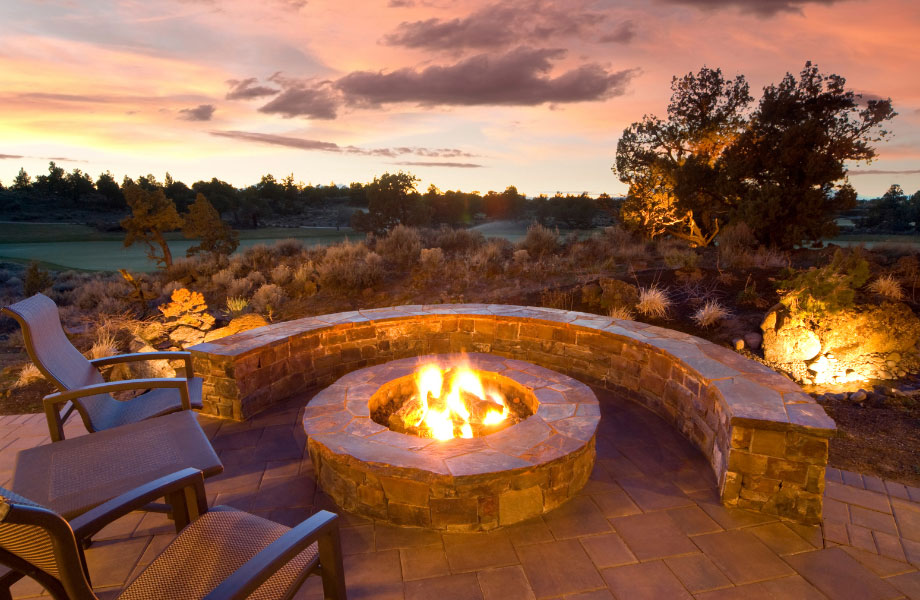
When it comes to enjoying your outdoor space, there’s nothing quite like gathering around a fire pit. Whether it’s with family or friends, a roaring fire can create the perfect ambiance for a relaxing evening under the stars. However, as with anything that involves intense heat and flames, it’s essential to take the necessary precautions to protect your patio from damage and your family from danger.
One of the most crucial things you need for protection is a spark screen. A spark screen is a mesh cover that fits over the top of your fire pit to prevent sparks and embers from flying out. These little pieces of hot debris can cause a lot of damage if they land on flammable materials nearby, like your patio or nearby plants. Not only can they cause a fire, but they can also cause burns or other injuries if they make contact with someone’s skin. A spark screen is an inexpensive accessory that can make a huge difference in keeping your outdoor space safe.
In addition to a spark screen, it’s also important to use heat shields and heat retardant mats to protect your patio surface from heat transfer. Heat shields are panels that you can place around your fire pit to help redirect heat away from the surrounding area. Heat retardant mats, on the other hand, are thick pads that you can place underneath your fire pit to create a barrier between the heat source and your patio. Both of these options can help prevent heat damage to your patio over time and give you added peace of mind.
Another effective way to protect your patio from a fire pit is by creating a layer of sand around the pit. Sand is a natural insulation material that absorbs heat and reduces the risk of fire. It can also be a great way to add an extra layer of protection if you have a wooden patio surface. Wooden patios are particularly susceptible to damage caused by fire pits, so it’s essential to use a heat-resistant mat or hinged doors to protect the structural integrity of the wood from pit damage.
Lastly, when using a fire pit, it’s crucial to have the right tools on hand, such as a bucket of water and a poker tool. In case of an accidental fire, having a bucket of water nearby can help you quickly extinguish the flames. A poker tool can also come in handy if you need to move logs around in the fire or adjust the position of the spark screen.
By taking these simple steps, you can safely and confidently enjoy your fire pit without worrying about the potential damage it may cause to your patio or your family. Remember to always be vigilant and mindful of your surroundings when using a fire pit, and enjoy your outdoor living space with peace of mind.
Heat Transfer Considerations
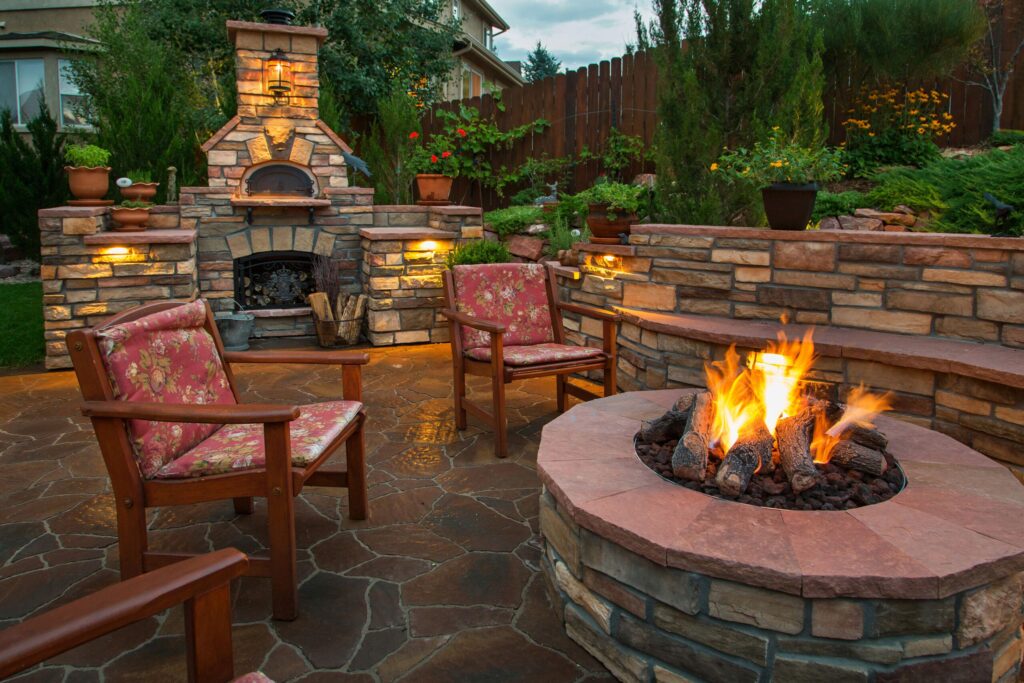
When it comes to using a fire pit in your outdoor space, it’s important to consider the potential heat transfer and how it could pose a risk to your patio or surrounding areas. Heat transfer occurs when heat moves from one object to another, such as when a fire pit radiates heat to nearby surfaces. This can cause damage or create a safety hazard, especially if you have flammable materials nearby.
One way to minimize heat transfer is to use a heat-resistant mat underneath your fire pit. These specialized mats are designed to withstand extreme temperatures and act as a barrier between the heat source and your patio surface. By using a heat-resistant mat, you can significantly reduce the risk of heat damage to your patio over time.
Another option for reducing heat transfer is to use heat shields or panels to direct heat away from your patio. Heat shields can be attached to your fire pit and work by reflecting heat back into the fire pit rather than allowing it to radiate outward. This not only reduces heat transfer but also helps to keep the fire contained within the pit.
In addition to using heat-resistant mats and shields, it’s important to consider the location of your fire pit. Placing your fire pit on a concrete patio or other non-flammable surface can help reduce the risk of heat transfer to surrounding areas. If you have a wooden deck or patio surface, it’s essential to use caution and take extra precautions to protect the wood from heat damage.
It’s also important to choose the right type of fire pit for your outdoor space. Gas fire pits or propane fire pits are typically safer than wood-burning fire pits because they produce less heat and don’t emit sparks or embers. If you do choose a wood-burning fire pit, be sure to use a spark screen to prevent hot embers from flying out and causing damage or injury.
Ultimately, when using a fire pit, it’s crucial to take heat transfer considerations seriously and take steps to protect your outdoor space. By using heat-resistant mats, shields, and taking other precautions, you can enjoy the warmth and ambiance of a fire pit while keeping your patio and surrounding areas safe.
Heat Shields and Thermal Barriers
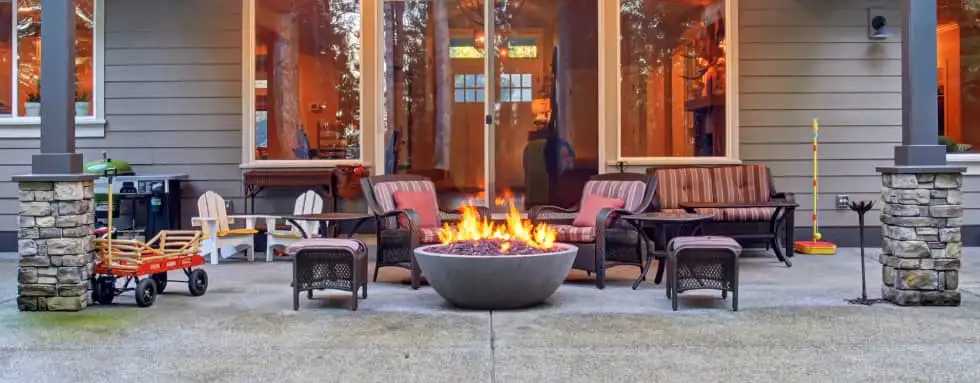
When it comes to enjoying the warmth and ambiance of a fire pit in your outdoor living space, safety should always be a top priority. Not only is it essential to practice responsible fire pit use and take precautions such as keeping a bucket of water and a poker tool nearby, but it’s also important to consider the impact that intense heat can have on your patio surface over time.
Heat transfer from your fire pit can cause damage to concrete surfaces, wood decks, and other patio materials, compromising their structural integrity and reducing their lifespan. To combat this issue, many homeowners opt to use heat-resistant mats, which act as a protective barrier between the fire pit and the patio surface.
Another option for reducing heat transfer is the use of heat shields or panels. These metal shields can be attached to your fire pit and work by reflecting heat back into the fire pit rather than allowing it to radiate outward. Heat shields not only reduce the risk of fire pit damage to your patio surface but also help to keep the fire contained within the pit.
While heat-resistant mats and heat shields are both effective methods for reducing heat transfer, it’s essential to consider their limitations. Heat-resistant mats are designed to withstand extreme temperatures but should not be used as a permanent solution as exposure to heat can cause the mat to degrade over time. Heat shields, on the other hand, work best for concentrated heat sources such as gas or propane fire pits and may not be as effective for wood-burning fire pits that produce a broader range of heat.
If you want to further protect your patio from heat transfer, consider using thermal barriers. These specially designed materials work by absorbing and reflecting heat, preventing it from penetrating through to the patio surface. Thermal barriers can be installed under paver stones or concrete slabs and can provide additional protection against intense heat.
When it comes to choosing the right fire pit for your outdoor space, consider factors such as the type of fuel, size, and location. Gas fire pits or propane fire pits are typically safer than wood-burning fire pits because they produce less heat and do not emit sparks or embers. Elevated fire pits and free-standing fire pits are excellent options for preventing direct heat transfer to your patio surface.
In conclusion, protecting your patio from fire pit damage requires a combination of responsible fire pit use and the use of appropriate heat shields, thermal barriers, and other protective measures. By taking a proactive approach, you can enjoy the warmth and ambiance of your fire pit while keeping your outdoor space safe and damage-free.
Heat Retardant Mats

When it comes to using a fire pit in your outdoor living space, one of the most important precautions you can take is to protect your patio surface from heat damage. Heat transfer from your fire pit can cause damage to concrete surfaces, wooden decks, and other patio materials, compromising their structural integrity and reducing their lifespan. One effective solution to this problem is to use heat-retardant mats, which act as a protective barrier between the fire pit and your patio surface.
Heat retardant mats are made from materials that are specifically designed to withstand extreme temperatures and prevent heat from penetrating through to your patio surface. They can be made from a variety of materials including ceramic, volcanic rock, or fiberglass, and come in various shapes and sizes to accommodate different fire pit designs.
When using a heat retardant mat, it’s essential to ensure that the mat is placed under your fire pit and covers a sufficient area to adequately protect your patio surface. While mats can vary in thickness and heat resistance, it’s generally recommended to use a mat that can withstand temperatures of up to 1400 degrees Fahrenheit.
One of the advantages of using a heat retardant mat is that it can provide protection not only from heat transfer but also from sparks and embers that can fly out of the fire pit. This makes it an ideal solution for wood-burning fire pits, which can produce more sparks and embers than gas or propane fire pits.
Using a heat retardant mat is also a relatively affordable solution to protect your patio surface from fire pit damage. Mats can be purchased online or at your local home improvement store, and installation is typically as simple as placing the mat under your fire pit.
While heat retardant mats are an excellent option for protecting your patio surface, it’s important to remember that they should not be used as a permanent solution. Exposure to heat over time can cause the mat to degrade, reducing its effectiveness. For this reason, it’s essential to check your mat regularly for signs of wear and tear and replace it as necessary.
Overall, using a heat retardant mat is an effective and affordable way to protect your patio from the damaging effects of heat transfer from your fire pit. By taking the necessary precautions, you can enjoy the warmth and ambiance of a fire pit in your outdoor living space while ensuring the long-term health and safety of your patio surface.
Materials That Should Not Be Used Around Fire Pits
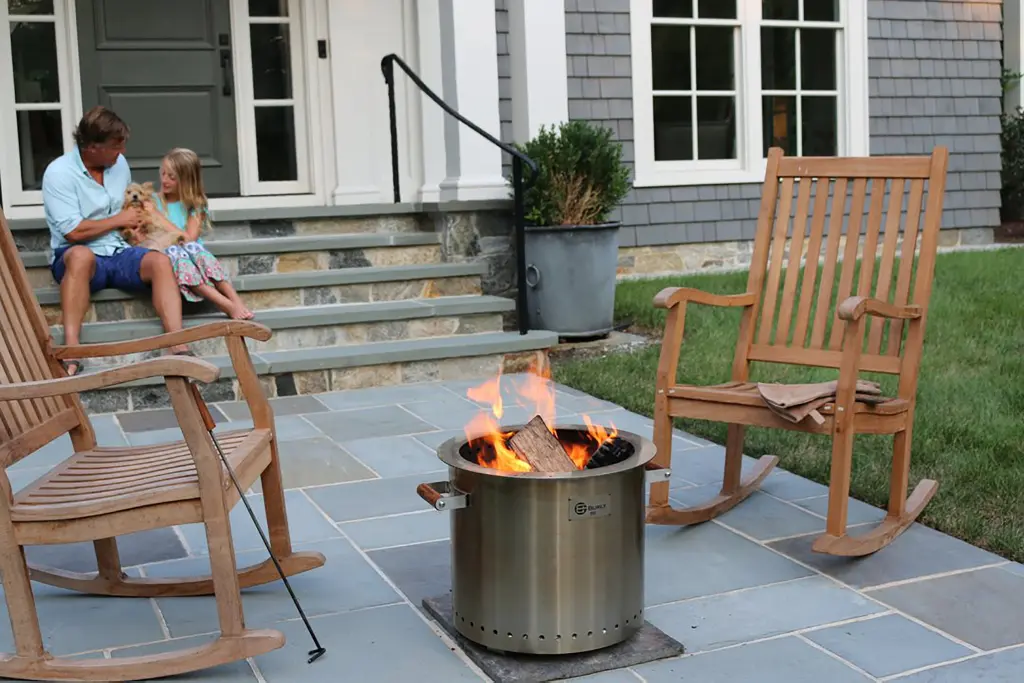
When it comes to having a fire pit in your outdoor living space, it’s crucial to be aware of the materials that should not be used around it. While fire pits can be a great way to enjoy the outdoors and entertain guests, they can also pose a significant fire hazard if not used properly.
First and foremost, it’s important to avoid using flammable materials near your fire pit. This includes anything made of wood, paper, or cardboard, as well as any flammable synthetic materials like plastic or nylon. All of these materials can ignite easily and spread flames quickly, putting you, your guests, and your property at risk.
Even if you’re not using a wood-burning fire pit, it’s still important to be mindful of the materials you’re using near it. Gas fire pits, for example, can still produce intense heat that can cause certain materials to melt or warp. It’s best to avoid using any materials that are heat-sensitive or can’t handle exposure to high temperatures.
Another material to avoid using around fire pits is anything that retains moisture or is prone to rusting. This includes materials like untreated metal or iron, which can easily corrode over time and become structurally compromised. Not only can this pose a safety risk, but it can also result in an unsightly outdoor space.
It’s also important to avoid using anything that can obstruct airflow around your fire pit. This means avoiding materials like heavy fabrics, blankets, or cushions that can cover your fire pit or prevent air from circulating. Proper airflow is essential for ensuring a fire burns safely and efficiently.
In general, it’s best to use materials that are specifically designed for use around fire pits. This includes things like heat-resistant stone or concrete surfaces, fire-resistant insulation, and durable metal or ceramic spark screens. When in doubt, always err on the side of caution and consult with a fire pit expert or a trusted home improvement retailer to find the right materials for your fire pit setup.
By being aware of the materials that should not be used around fire pits, you can ensure that your outdoor living space remains safe and enjoyable for years to come. Remember, safety should always be a top priority when it comes to enjoying your fire pit, so take the time to choose the right materials and use them properly.
Flammable Materials Near a Fire Pit
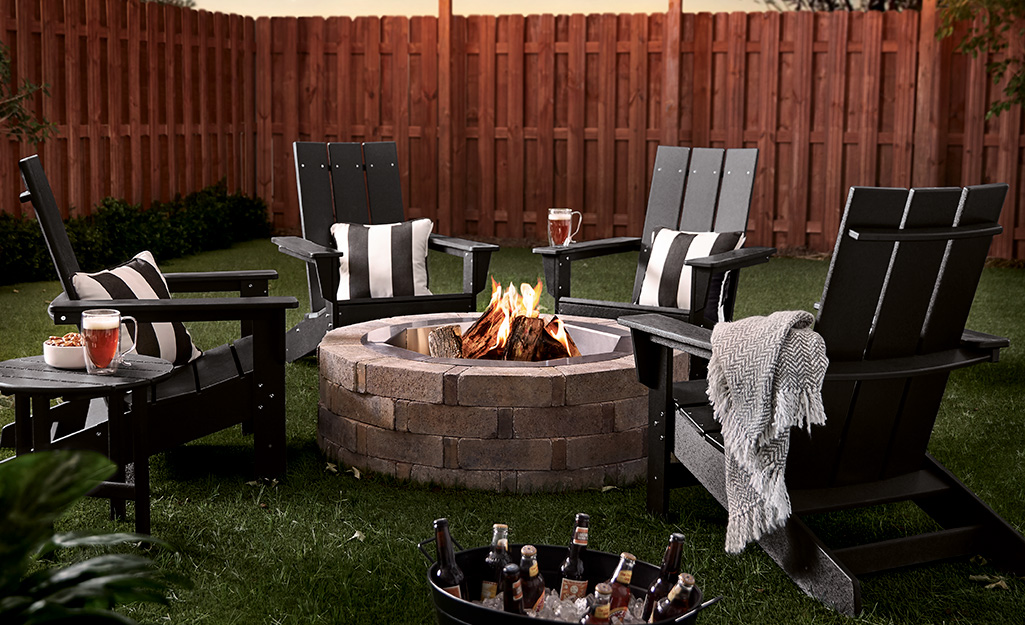
When it comes to the safety of your outdoor living space, few things pose as much of a risk as flammable materials near your fire pit. This is especially true for wood-burning fire pits, which can produce embers and sparks that can easily ignite surrounding materials.
Some common flammable materials to avoid using near your fire pit include wood, paper, cardboard, plastic, and nylon. All of these materials can ignite quickly and spread flames rapidly, putting you and your property at risk.
Even if you are using a gas fire pit, it’s still important to be mindful of the materials around it. Gas fire pits can produce intense heat that can cause certain materials to melt or warp. Heat-sensitive materials or those that can’t handle exposure to high temperatures should be avoided.
It’s also important to keep moisture-retaining materials away from your fire pit. This includes untreated metal or iron, which can easily corrode over time, becoming structurally compromised and posing a safety risk. In addition, materials like fabric, blankets, or cushions that can cover your fire pit or prevent air from circulating should be avoided since proper airflow is essential for a safe and efficient fire.
Using materials that are specifically designed for use around fire pits is the best course of action. These materials include heat-resistant stone or concrete surfaces, fire-resistant insulation, and durable metal or ceramic spark screens. When in doubt, consult with a fire pit expert or trusted home improvement retailer to find the safest materials for your outdoor space.
Overall, it’s critically important to take measures to keep flammable materials away from your fire pit. Doing so will help ensure the safety of you, your guests, and your property for years to come.
Wood Decks and Fire Pits Don’t Mix
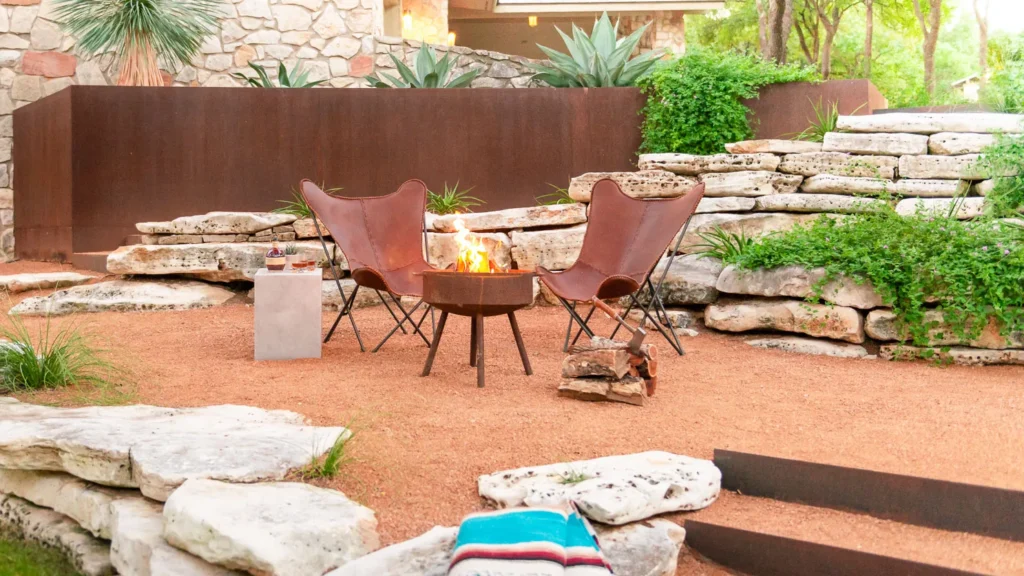
Wood decks are a popular feature in many homes, providing a beautiful and functional outdoor living space. Adding a fire pit to a wooden deck can also seem like an excellent option, allowing you to enjoy the warmth and ambiance of a fire while also providing a cozy gathering place for family and friends.
However, it’s important to understand that wood decks and fire pits don’t mix. Both wood-burning and gas fire pits can produce extreme heat that can damage or even ignite a wooden deck. The intense heat can cause the surface of the wood to discolor, warp, and even catch fire, putting your family and home at risk.
In addition, wood decks are made of flammable materials that can ignite quickly and spread flames rapidly. This includes the wooden planks, railings, and stairs that make up the deck’s structure. If a fire breaks out, it can quickly engulf the entire deck and potentially spread to the house or surrounding yard.
To protect your home and family, it’s essential to take steps to prevent fire pit damage to your wooden deck. This can include using a heat-resistant mat or thermal barrier to protect the deck’s surface from the intense heat of the fire pit. Heat shields or hinged doors can also provide additional protection by blocking the heat and preventing sparks from escaping.
If you are planning to install a fire pit in your backyard, consider choosing a location that is not on or directly adjacent to your wooden deck. Elevated fire pits that are free-standing and can be moved away from the deck are also an excellent option. Natural gas-fueled fire pits are another great choice since they produce less heat than a wood-burning fire pit.
In conclusion, while wood decks may seem like the perfect spot for a fire pit, this is not the case. The intense heat produced by the fire pit can cause serious damage to the deck’s surface and can even put your home and family at risk. By taking preventative measures and choosing a safe location, you can still enjoy the warmth and ambiance of a fire pit without risking the structural integrity of your wooden deck.
Concrete Surfaces and Fire Pits
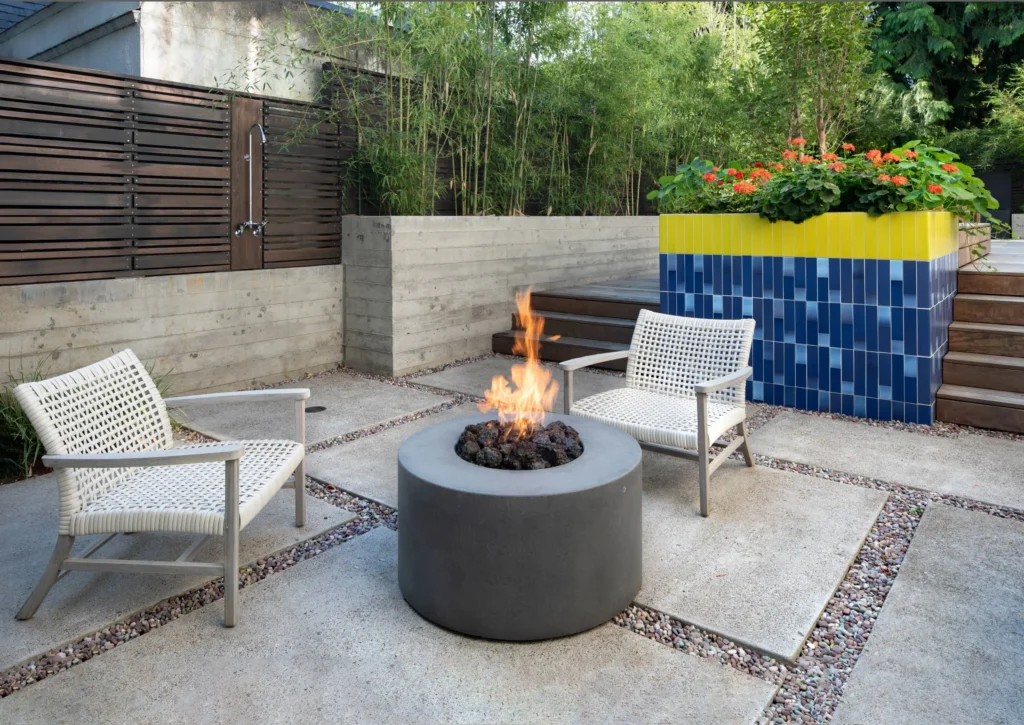
Fire pits are a popular addition to any outdoor living space, providing warmth and a cozy ambiance. However, it’s essential to protect your patio or outdoor area, particularly if it’s made of concrete. Concrete surfaces are durable and sturdy, but they can still suffer damage from intense heat.
One of the significant risks associated with fire pits and concrete surfaces is the potential for heat damage. The extreme heat produced by wood-burning or gas fire pits can cause the concrete to crack or become discolored over time. This damage can be unsightly and potentially compromise the structural integrity of the surface.
To prevent damage and maintain the appearance of your concrete patio, consider using a heat-resistant mat or thermal barrier beneath your fire pit. These products are designed to protect the surface from direct contact with the high temperatures produced by the fire pit. They also prevent burns and other heat-related injuries to users or guests.
An alternative solution that can also provide additional protection is the use of a spark screen. This mesh screen is placed over the fire pit to capture any embers or sparks that may fly out, preventing them from landing on the surface and causing damage. Spark screens are an affordable and practical option to prevent heat damage to your concrete surface.
Another factor to take into consideration when using fire pits on concrete surfaces is the potential for flammable materials. It’s essential to keep flammable materials like paper, leaves, and other debris away from the fire pit. This step can help prevent accidental fires from igniting that could quickly spread to surrounding areas.
In conclusion, while concrete surfaces are a great option for outdoor patios and living spaces, it’s crucial to take the necessary precautions to protect them from fire pits’ intense heat. By using heat-resistant mats, spark screens, and avoiding flammable materials, you can enjoy your fire pit safely and keep your concrete surface in excellent condition for many years to come.
How to Protect Concrete Patios from a Fire Pit?
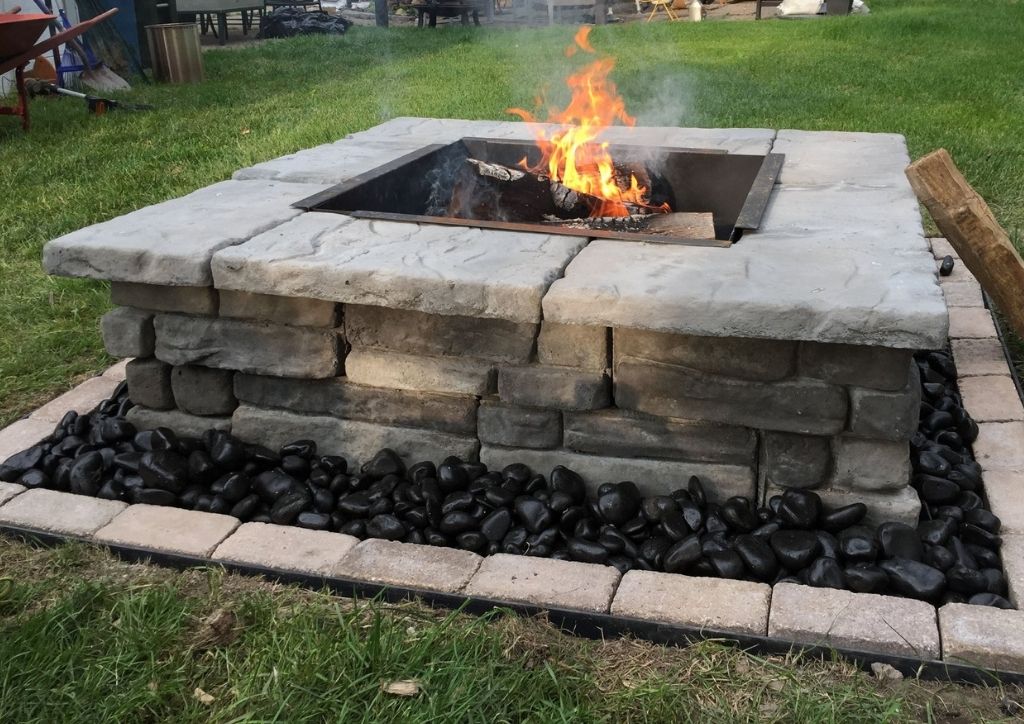
Concrete patios are a popular choice for outdoor living spaces, providing a durable and low-maintenance surface for relaxation and entertainment. However, when it comes to using a fire pit on your patio, there are some important precautions to take to protect your concrete surface from damage.
One of the biggest risks associated with fire pits and concrete surfaces is the high temperatures produced by wood-burning or gas fire pits. Over time, exposure to this intense heat can cause the concrete to crack, discolor, or even break down completely.
To prevent damage and maintain the appearance of your concrete patio, there are several measures you can take to protect it from your fire pit’s heat:
1. Use a Heat-Resistant Mat or Thermal Barrier
A heat-resistant mat or thermal barrier is an excellent option for protecting your concrete patio from fire pit heat. These products are designed to withstand high temperatures and can be placed beneath your fire pit to prevent direct contact with the surface.
Not only do heat-resistant mats and thermal barriers protect your concrete from heat damage, but they also provide additional safety benefits by preventing burns and other heat-related injuries to users or guests.
2. Install a Spark Screen
A spark screen is another essential tool for protecting your concrete patio from fires caused by stray embers or sparks. These mesh screens are placed over the fire pit to catch any debris that may fly out, preventing them from landing on the surface and causing damage.
Spark screens are an affordable and practical option for keeping your concrete patio safe from harm while still allowing you to enjoy the warmth and ambiance of your fire pit.
3. Keep Flammable Materials Away from the Fire Pit
It’s essential to keep flammable materials like paper, leaves, and other debris away from your fire pit to prevent accidental fires from igniting. Be sure to clear any materials from the surrounding area before starting your fire, and make sure to keep a bucket of water or fire extinguisher on hand in case of an emergency.
Overall, protecting your concrete patio from your fire pit’s heat is crucial to maintain the surface’s appearance and structural integrity. By using a heat-resistant mat or thermal barrier, installing a spark screen, and keeping flammable materials away from the fire pit, you can enjoy the warmth and beauty of your fire pit while keeping your patio safe and protected.
What Happens to Concrete Over Time With a Fire Pit?
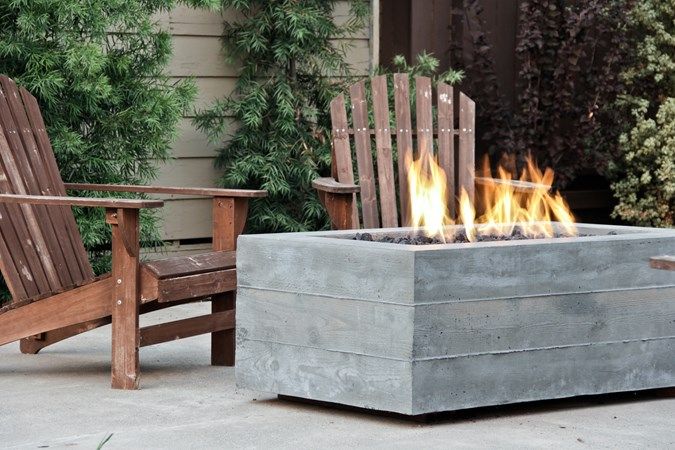
A fire pit can be a wonderful addition to your backyard, providing a warm and inviting ambiance for you and your guests to enjoy. However, it’s important to be aware of the potential risks associated with placing a fire pit on your concrete patio. Over time, exposure to the extreme heat produced by a wood-burning or gas fire pit can cause significant damage to the concrete surface.
One of the most common issues with concrete and fire pits is cracking. The intense heat causes the concrete to expand and contract, which can lead to small cracks forming. If left unaddressed, these cracks can grow larger over time, compromising the structural integrity of the concrete. Additionally, the concrete may become discolored or even begin to crumble as a result of prolonged exposure to extreme heat.
To prevent this kind of damage, it’s important to take measures to protect your concrete patio. One of the most effective ways to do this is to use a heat-resistant mat or thermal barrier. These products are designed to withstand high temperatures and can be placed beneath your fire pit to prevent direct contact with the surface. Not only do heat-resistant mats and thermal barriers protect your concrete from heat damage, but they also provide additional safety benefits by preventing burns and other heat-related injuries to users or guests.
Another important precaution is to keep flammable materials away from your fire pit. Be sure to clear any debris or materials from the surrounding area before starting your fire, and keep a bucket of water or fire extinguisher on hand in case of an emergency. It’s also a good idea to install a spark screen over your fire pit to prevent embers or sparks from landing on the concrete surface.
In addition to these preventative measures, it’s important to regularly inspect your concrete patio for signs of damage. If you notice any cracks or discoloration, it’s best to address them as soon as possible to prevent further deterioration. You may need to have the concrete resealed or repaired to maintain its appearance and structural integrity over time.
Overall, while a fire pit can be a wonderful addition to your outdoor space, it’s important to be aware of the potential risks to your concrete patio. By taking the necessary precautions and regularly inspecting your patio for damage, you can ensure that your fire pit remains a safe and enjoyable addition to your backyard for years to come.
Portable vs. Permanent Fire Pits
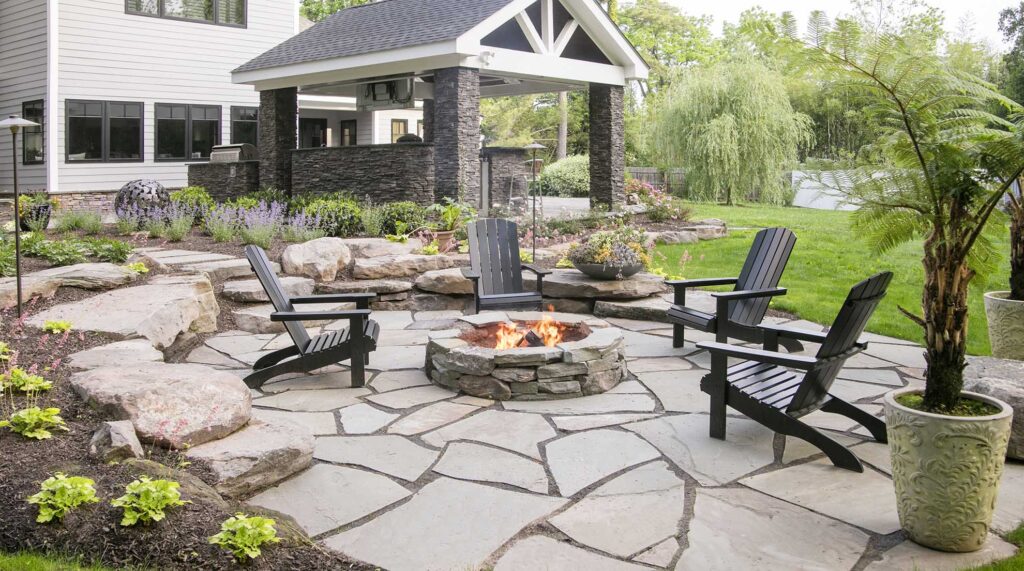
Fire pits have become an increasingly popular addition to outdoor living spaces in recent years, and for good reason. They provide a cozy and inviting atmosphere, create warmth, and can even serve as a cooking source. When considering a fire pit, one of the first decisions to make is whether to go with a portable or permanent option.
Portable fire pits offer flexibility in terms of placement and can be easily moved from one location to another. They come in a variety of sizes, shapes, and materials, from metal bowls to clay chimineas and even small tabletop options. Many portable fire pits are fueled by wood, making them a great option for those who prefer the crackling sound and smoky scent of a wood-burning fire. They are also often less expensive than permanent fire pits, making them a budget-friendly option.
However, portable fire pits do have their drawbacks. Safety is a concern, especially when using an above-ground option. It’s important to always place the fire pit on a non-flammable surface, away from any overhanging branches or flammable materials. They may also not be as durable as permanent options, particularly if exposed to the elements frequently.
Permanent fire pits, on the other hand, are built into the ground or a patio surface and are designed to last for years. They offer a more polished and cohesive look to outdoor spaces and can even add value to a home. Permanent fire pits can be fueled by a variety of sources, including natural gas and propane, in addition to wood.
One of the main advantages of a permanent fire pit is safety. They are built with fire-resistant materials and are typically equipped with hinged doors and other safety features that prevent embers from escaping. They also offer a more stable and secure base for the fire, preventing tip-overs or other accidents.
While permanent fire pits offer many benefits, they do come at a higher cost and require professional installation. They also lack the same level of flexibility as portable options when it comes to placement, so it’s important to carefully consider the best location before installation.
Ultimately, the decision between a portable or permanent fire pit will depend on individual preferences and needs. Portable fire pits offer flexibility and affordability, while permanent options provide safety and durability. Regardless of which type of fire pit is chosen, it’s important to take precautions and practice safe fire etiquette to ensure a fun and enjoyable outdoor experience.
Pros and Cons of Portable vs. Permanent Fire Pits
When it comes to adding a fire pit to your outdoor living space, there are two main options to consider: portable or permanent. Each option comes with its own set of pros and cons, and it’s important to weigh these factors before making a decision.
Portable fire pits offer flexibility in terms of placement. They can be easily moved from one location to another and come in a variety of sizes, shapes, and materials. Some even offer the option to cook over the open flame. Portable fire pits are often fueled by wood, making them a great option for those who prefer the crackling sound and smoky scent of a wood-burning fire. They are also usually less expensive than permanent fire pits, making them a budget-friendly option.
However, portable fire pits do have their drawbacks. Safety is a concern, especially when using an above-ground option. It’s important to always place the fire pit on a non-flammable surface, away from any overhanging branches or flammable materials. Portable fire pits may also not be as durable as permanent options, particularly if exposed to the elements frequently.
Permanent fire pits, on the other hand, are built into the ground or a patio surface and are designed to last for years. They offer a more polished and cohesive look to outdoor spaces and can even add value to a home. Permanent fire pits can be fueled by a variety of sources, including natural gas and propane, in addition to wood.
One of the main advantages of a permanent fire pit is safety. They are built with fire-resistant materials and are typically equipped with hinged doors and other safety features that prevent embers from escaping. They also offer a more stable and secure base for the fire, preventing tip-overs or other accidents.
While permanent fire pits offer many benefits, they do come at a higher cost and require professional installation. They also lack the same level of flexibility as portable options when it comes to placement, so it’s important to carefully consider the best location before installation.
Ultimately, the decision between a portable or permanent fire pit depends on individual preferences and needs. Those who prioritize flexibility and affordability may prefer a portable option, while those who prioritize safety and a polished look may opt for a permanent fire pit. Whichever option is chosen, always remember to practice proper fire safety and use caution when enjoying an outdoor fire.
Extreme Heat Considerations
When it comes to enjoying the warmth and ambiance of a fire pit on your patio, it’s important to consider the potential risks and hazards associated with it. One of the biggest concerns to keep in mind is extreme heat.
Whether you have a portable or permanent fire pit, the intense heat generated by the flames can cause damage to surrounding surfaces and materials. Wooden decks and patios are particularly susceptible to heat damage, as well as concrete surfaces over time. This can not only compromise the structural integrity of your outdoor space but also create an unsightly appearance.
To prevent heat damage to your patio surfaces, it’s important to use a layer of sand as a barrier between your fire pit and the ground, which can absorb some of the heat. A heat-resistant mat or shield can also add an additional layer of protection between the fire pit and your patio surface.
Another consideration when it comes to extreme heat is the potential for sparks or embers to escape from your fire pit, which can ignite flammable material nearby. To prevent this, it’s recommended to use a spark screen to contain any flying debris.
It’s also important to be mindful of heat stress on your fire pit itself. While wood-burning fire pits may not require as much attention as gas or propane options, all fire pits can be affected by intense heat over time. Make sure to follow the manufacturer’s instructions for proper use and maintenance to prevent any potential pit damage.
In addition to taking steps to protect against extreme heat, it’s important to have the proper tools on hand to maintain your fire pit and prevent accidents. A poker tool and bucket of water can be excellent options for managing the flames and ensuring your fire pit is well-maintained.
Overall, keeping extreme heat in mind as a potential hazard when using a fire pit on your patio is essential for both safety and the longevity of your outdoor living space. With proper precautions and maintenance, you can enjoy the warmth and ambiance of a fire pit without putting your home or backyard at risk.
Gas, Propane, and Wood-Burning Fire Pits: What’s the Difference?
If you’re considering adding a fire pit to your backyard or outdoor living space, you may be wondering about the different types of fire pits available. Gas, propane, and wood-burning fire pits are all popular options, each with their own unique features and benefits. Here’s a breakdown of each type and what sets them apart.
Gas Fire Pits:
Gas fire pits are fueled by natural gas or propane gas, making them a convenient and low-maintenance option. They are often designed with a sleek and modern look and can be easily turned on and off with a switch or remote control. Gas fire pits are also cleaner-burning than their wood-burning counterparts, producing less smoke and particulate matter.
Propane Fire Pits:
Propane fire pits are similar to gas fire pits but are designed to be portable and can be fueled by standard-sized propane tanks. This makes them an excellent option for camping trips or other outdoor adventures. Propane fire pits also have the advantage of being easy to set up and take down, as they don’t require a permanent gas line connection.
Wood-Burning Fire Pits:
Wood-burning fire pits are the most traditional option and offer a rustic and natural aesthetic. They are fueled by wood and require more attention and maintenance than gas or propane fire pits. Wood-burning fire pits are also more susceptible to sparking and embers, which can pose a risk to nearby flammable materials. However, many people prefer the ambiance and aroma of a wood-burning fire pit.
So which type of fire pit is right for you? It ultimately depends on your personal preferences and needs. If you value convenience and low-maintenance, a gas or propane fire pit may be the best choice. If you love the smell and sound of crackling wood and don’t mind the extra maintenance, a wood-burning fire pit may be more your style. Regardless of which type you choose, a fire pit can add warmth and atmosphere to your outdoor living space for years to come.




